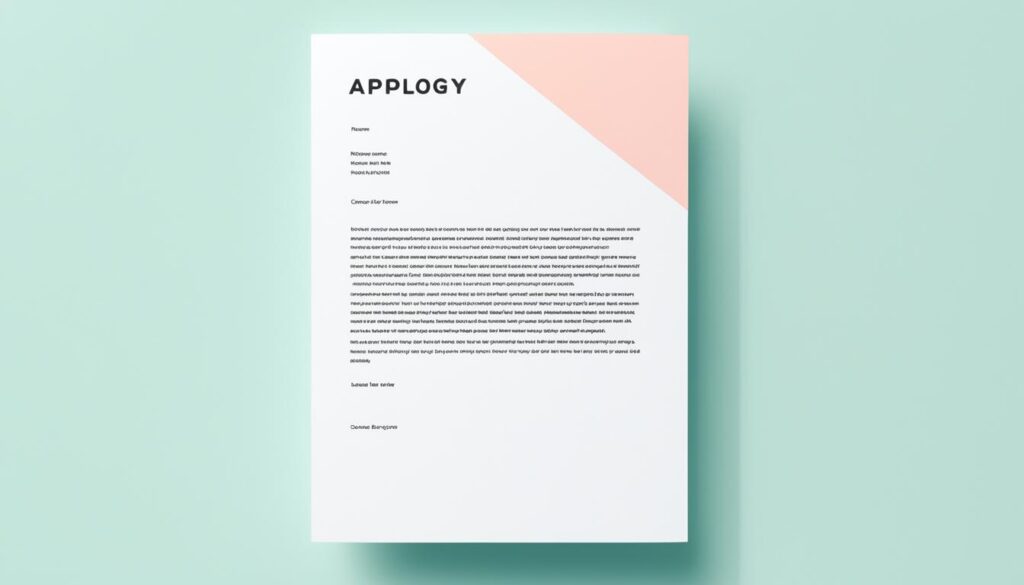Apologizing for bad customer service is an essential skill for businesses. When mistakes happen, a sincere apology can help maintain customer satisfaction and loyalty. Crafting the perfect apology requires more than just saying sorry. It involves acknowledging the mistake, taking responsibility, and outlining a solution to rectify the situation. In this article, we will explore the best practices for apologizing and provide templates that you can use in different scenarios. Whether you need to apologize for a negative customer service experience, a late shipment, or a billing error, we’ve got you covered.
Key Takeaways:
- Apologizing for bad customer service is crucial for maintaining customer satisfaction and loyalty.
- Avoid common mistakes such as downplaying customer feelings or making excuses.
- Offer a sincere apology, take ownership of the mistake, and clearly explain what happened.
- Outline the steps you will take to rectify the situation and ensure customer satisfaction.
- Follow up with the customer to demonstrate your commitment to resolving the issue.
Common Mistakes Businesses Make When Apologizing
When it comes to apologizing to customers for bad service, there are some common mistakes that businesses often make. It’s important to avoid these errors, as they can make the apology seem insincere and jeopardize customer satisfaction.
To ensure that your apology resonates with customers, here are some key mistakes to avoid:
- Playing down customer feelings: Acknowledge the impact of the mistake on the customer and empathize with their emotions. Avoid trivializing or dismissing their concerns.
- Failing to own up to mistakes: Take full responsibility for the error or poor service. Avoid shifting blame or making excuses that diminish accountability.
- Making promises that cannot be kept: Be realistic and honest about the steps you will take to rectify the situation. Avoid making promises that you cannot fulfill.
- Keeping the apology vague: Clearly explain what went wrong and how it affected the customer. Avoid using ambiguous language that fails to address the specifics of the issue.
- Apologizing too much: While apologies are important, excessive apologizing can come across as insincere or disingenuous. Strike a balance and focus on meaningful actions to make amends.
- Offering a begrudging apology: Make sure your apology is genuine and heartfelt, without any trace of resentment or irritation. Customers can detect insincerity, so ensure that your words and tone convey authentic remorse.
By avoiding these common mistakes, you can strengthen your customer relationships through sincere and effective apologies.

Apology Best Practices
When it comes to apologizing, following best practices can make a significant difference in the effectiveness of your apology. By incorporating these strategies, you can craft a heartfelt apology that resonates with your customers and demonstrates your commitment to their satisfaction.
Offer a Sincere Apology
An effective apology begins with a sincere expression of remorse. Use heartfelt language to convey your genuine regret for any inconvenience or negative experience your customer may have endured.
Keep It Short and Sweet
When apologizing, it’s important to keep your message concise and focused. Avoid unnecessary details or explanations that might dilute the sincerity of your apology. Instead, get straight to the point and acknowledge the mistake.
Take Ownership of the Mistake
Accepting responsibility is an essential part of a sincere apology. Avoid shifting blame or making excuses. Instead, acknowledge the error and take full ownership of the mistake. This demonstrates accountability and shows the customer that you are committed to making it right.
Explain What Happened
Provide a clear and concise explanation of what happened to cause the problem. Offering transparency allows the customer to understand the situation better and can help rebuild trust.
Outline the Solution
In addition to explaining the mistake, it’s crucial to outline the steps you will take to address the customer’s concerns. Whether it’s offering a refund, providing a replacement, or implementing a solution, be specific and proactive in your approach. This reassures the customer that you’re actively working towards a resolution.

Follow Up
After delivering your apology, don’t forget to follow up with the customer. This proactive approach shows that you value their feedback and are committed to their satisfaction. By reaching out to ensure their concerns have been resolved, you can build a stronger relationship with your customers and mitigate any potential negative impact.
| Effective Apology Strategies | Best Practices for Apologizing | Crafting a Heartfelt Apology |
|---|---|---|
| Offer a sincere apology | Keep it short and sweet | Take ownership of the mistake |
| Explain what happened | Outline the solution | Follow up with the customer |
Templates You Can Use When Making an Apology
When it comes to making an apology, having templates can be a valuable resource. Templates not only save you time but also ensure consistency in your apologies. Whether you need to apologize for a negative customer service experience, a website or system outage, a late or lost shipment, a wrong order, or a billing error, having a well-crafted apology template at your disposal can make the process easier and more efficient.
By utilizing apology letter templates, sample apology emails, and apology letter examples, you can tailor your apologies to fit different scenarios while maintaining a professional and effective tone.
To help you get started, here are some key elements to consider when using apology templates:
- Clear acknowledgment: Begin your apology by acknowledging the mistake or issue that occurred. This demonstrates your understanding of the problem and shows empathy towards the affected individual.
- Sincere expression of regret: Apologize sincerely and express genuine regret for the inconvenience or harm caused. This helps rebuild trust and shows your commitment to addressing the situation appropriately.
- Explanation and accountability: Clearly explain what went wrong and take responsibility for the mistake. Avoid making excuses or shifting the blame, as this can undermine the sincerity of your apology.
- Proposed solution or corrective action: Outline the steps you will take to rectify the situation and prevent similar issues from happening in the future. Providing a tangible resolution demonstrates your commitment to resolving the problem.
- Follow-up and reassurance: Conclude your apology by reassuring the recipient that you value their feedback and will continue to work towards improving their experience. Offer to follow up with them personally to ensure their satisfaction.
Remember, while templates can provide a useful starting point, it’s important to personalize them according to your brand’s voice and the specific circumstances of the apology. By using apology letter templates, sample apology emails, and apology letter examples as a foundation, you can navigate the apology process with ease, maintain consistency, and convey sincerity to those you’re apologizing to.

Apologizing to Angry Customers
When it comes to dealing with angry customers, it’s crucial to approach the situation with empathy and patience. The key to turning an angry customer into a satisfied one lies in your ability to acknowledge their frustration and sincerely apologize for any mistakes made. By doing so, you can calm their anger and work towards finding a resolution that meets their needs.
Here are some steps to follow when apologizing to angry customers:
- Acknowledge their frustration: Let the customer know that you understand their frustration and that their feelings are valid. Validating their emotions can help ease their anger and create a sense of empathy.
- Express regret: Apologize sincerely for any mistakes that were made. Taking full responsibility and acknowledging your errors can go a long way in appeasing an angry customer.
- Offer a solution: Provide a solution or alternative that addresses the customer’s concerns. Whether it’s a refund, a replacement item, or a discount on their next purchase, offering a resolution demonstrates your commitment to making things right.
- Stay calm and composed: Emotions can run high in customer service interactions, but it’s crucial to remain calm and composed. Responding with anger or frustration will only escalate the situation. Instead, approach the conversation with understanding and a willingness to listen to the customer’s perspective.
By following these steps, you can effectively apologize to angry customers and work towards resolving their issues. Remember, the goal is to turn a negative experience into a positive one and leave the customer feeling valued and satisfied.

| Benefits of Apologizing to Angry Customers | Impact |
|---|---|
| 1. Enhances customer satisfaction | Customers feel heard and validated, increasing their overall satisfaction with your brand. |
| 2. Builds customer loyalty | By addressing and resolving the customer’s concerns, you demonstrate your commitment to their satisfaction and foster loyalty. |
| 3. Improves brand reputation | A sincere apology can help repair any damage to your brand’s reputation, showing that you value your customers and their experiences. |
Apologizing to angry customers is an opportunity to not only resolve their immediate concerns but also strengthen the relationship with your customer base. By handling these situations with empathy, professionalism, and a genuine desire to make things right, you can turn unhappy customers into your biggest advocates.
Setting the Right Expectations
When you are apologizing to customers, it is crucial to set appropriate expectations for resolving their concerns. Honesty is key here. Be transparent about the time it will take to address the issue and make sure to fulfill your promises. If an immediate resolution is not possible, clearly communicate the steps you are taking to address the problem and provide any temporary solutions or alternatives that are available. By setting the right expectations, you can effectively manage customer satisfaction and build trust.
Managing customer expectations starts with understanding their needs and concerns. Take the time to listen and empathize with their frustrations. Once you have a clear understanding of the problem, communicate a realistic timeline for resolution. This lets customers know what to expect and helps to avoid any disappointments or misunderstandings along the way.
During the resolution process, keep the lines of communication open. Regularly update customers on the progress and any changes that may occur. This demonstrates that you are actively working on their concerns and keeps them informed, further enhancing their trust in your commitment to resolving the issue. Remember, effective communication is a crucial aspect of managing customer expectations and delivering a positive customer experience.
FAQ
How should I apologize for bad customer service?
To apologize for bad customer service, it is important to avoid common mistakes such as downplaying customer feelings or making excuses. Instead, offer a sincere apology and take ownership of the mistake. Clearly explain what happened and outline the steps you will take to rectify the situation. Finally, don’t forget to follow up with the customer to ensure their satisfaction.
What are the common mistakes businesses make when apologizing?
Some common mistakes businesses make when apologizing include playing down customer feelings, failing to own up to mistakes, making promises that cannot be kept, keeping the apology vague, apologizing too much, and offering a begrudging apology. Avoiding these mistakes can help create a genuine and effective apology.
What are some best practices for apologizing?
To ensure that your apology is effective, it is important to offer a sincere apology and keep it short and sweet. Take ownership of the mistake and explain what happened to cause the problem. Outline the solution you will provide to address the customer’s concerns. Finally, don’t forget to follow up with the customer to ensure that the apology was effective and to demonstrate your commitment to their satisfaction.
Are there templates I can use when making an apology?
Yes, having templates can be helpful when making an apology, as it saves time and ensures consistency. Some common scenarios that may require an apology letter include negative customer service experiences, website or system outages, late or lost shipments, wrong orders, and billing errors. By using these templates and personalizing them to fit your brand, you can make sure your apologies are professional and effective.
How should I apologize to angry customers?
When dealing with angry customers, it is important to handle the situation with empathy and patience. Acknowledge their frustration and express regret for the mistake. Take full responsibility for the error and provide a solution or alternative to address their concerns. By staying calm and understanding, you can turn an angry customer into a satisfied one.
How can I set the right expectations when apologizing?
When apologizing to customers, it is important to set the right expectations regarding the resolution of their concerns. Be honest about the time it will take to resolve the issue and follow through on your promises. If a resolution cannot be provided immediately, communicate the steps you are taking to address the problem and offer any temporary solutions or alternatives. By setting the right expectations, you can manage customer satisfaction and trust.
